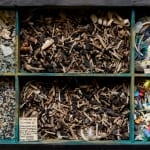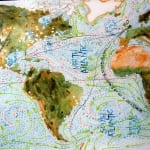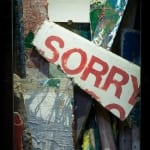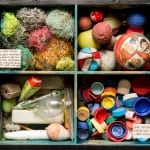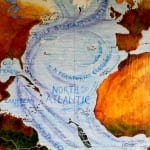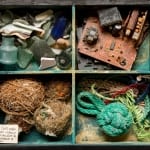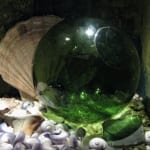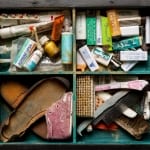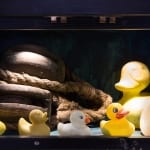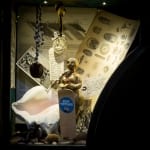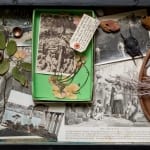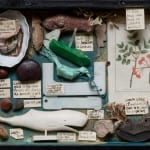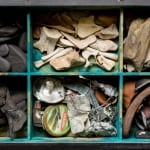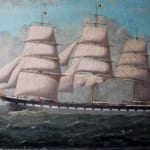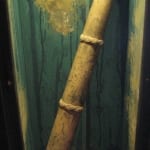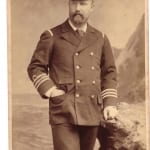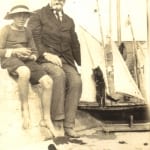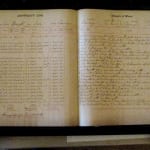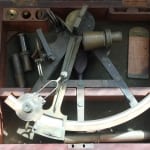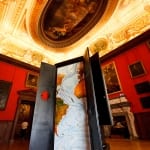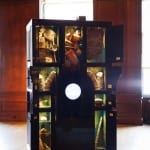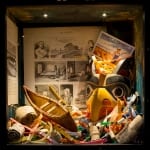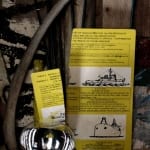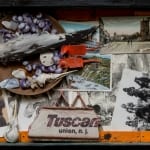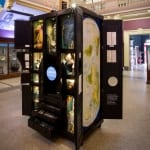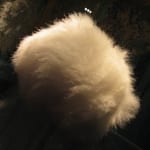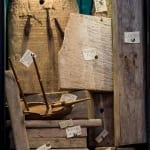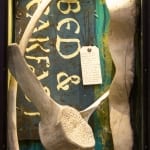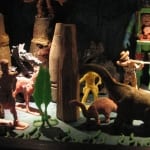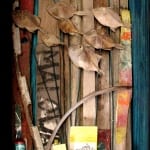THE CABINET OF THE SEA and THE MUSEUM OF US
Wild Works asked me to fill their cabinet twice, in the Enchanted Palace Exhibition at Kensington Palace, 2012 and at The Royal Cornwall Museum, Truro in 2013.
The second cabinet showed how our history is linked to the ocean currents of the world. The journeys made along these currents by Cornish people for exploitation of resources and work. It also held objects made by the people already living in the places they settled, the Native American and Maori, those peoples who were displaced by the settlers’ arrival.
It also contained objects brought back by the same currents to Cornish beaches, seeds from the Americas, Ambergris from a sperm whale and the plastic which now circles the globe because of our exploitation and extraction.
The cabinets held my collection of objects brought by the sea, collected over a period of 30 years from the north coast of Cornwall.
THE MAPS
The Map of the Atlantic shows the most significant ocean currents in the North and South Atlantic. The warm currents start at the Equator, these are painted mauve. The deep water cold currents are painted blue. As they rise at the Equator they bring nutrients from the deep ocean. The map shows how the North and South Atlantic are connected to each other and where the currents flow out to join the oceans of the world.
The Gulf Stream, the North Atlantic Current and the Labrador Current brought all these objects to Cornish beaches.
The map was inspired by the Robert Robinson’s map on the wind dial in The Gallery of War and Play in Kensington Palace. The places on that map are very selective. I only marked places that are important to me, mostly places where things I found have come from.
I marked the migration route of the artic tern the creature which travels further in its life time than any other, from Artic to Antarctic and back every year. The Loggerhead turtle travels the North Atlantic gyre, up the Gulf Stream and back round to the Caribbean to lay its eggs. The sperm whale travels around all the oceans of the world. The king penguin lives on the South Atlantic ice and albatross range the southern ocean.
I marked the Amazon because that’s where some of the largest of the seeds and beans have come from. They travel out into the open sea and the Equatorial Current, which brings them to the Caribbean then through the Florida Straights and into the Gulf Stream. Many seeds land on Coco Beach in Florida where American collectors wait for them. Cape Hateris is another collection point.
Maine and Cape Cod on the coast of North America and Labrador and Newfoundland on the coast of Canada are places from which I find fishing gear. The buoys and fisheries tags float down the Labrador Current and join the Gulf Stream then float on the Cornwall.
I marked most of the Islands and significant historical ports around the Atlantic out of interest.
The Map of the World (on its side)
This map shows all the ocean currents, warm and cold, and the trade routes used by sailing ships and all the places that Cornish people settled for the extraction of minerals and started new communities to found the Cornish Diaspora.
The Collection
The Sextant, telescope and Abstract Log where all used by Temperley Darke for his voyages, mainly around the South China Seas. The company traded in tea and china. He also worked ships to the Caribbean. I have a cabinet in my house once used to ship cigars across from Cuba. The Abstract log details the ships position, the sea state, weather and the fuel consumption on each voyage.
The seeds and beans were collected from many different beaches on the North Cornish coast. They are very rare. Most winters I only find one or two. I have grown many of them. They have evolved to be transported by the sea. They harden in salt water and soften in fresh water. The largest, the Sea Heart (Entada Gigas) which means BIG BEAN in Latin, is the largest member of the pea family. It grows 100 metres up into the canopy of the rain forest. It’s a Liana, the pod is segmented and monkeys climb it so it’s also called the Monkey Ladder Vine.
The bean with a large black band is the Mucuna or Hamburger bean. It has waxy flowers that are pollinated by bats.
The smallest seeds (Ipomoea) grow on the shores of the Caribbean and Central America.
I have found several coconuts. This one was sitting on sea coal. In Cornwall this washes onto most beaches and has come from coal ships wrecking off the coast and the holds of other wrecked vessels once powered by steam.
The pieces of Lignum Vitae (wood of life) were once used as bushes (bearings) for propellers. The wood is high in resin and so was self-lubricating. These pieces can be found all over the world, especially near harbours. The wood is very dense and grows in Jamaica where it’s the national tree. The trees have violet flowers, are now very rare and are an internationally protected species.
The lighters come from ship’s chandlers and bars in harbours all around the Atlantic. They represent the nations that use the Atlantic for trade and fisheries.
There are several different types of fishing float in the cabinet. The green glass float and the cork float with PL on it are the oldest. At least 100 years old, perhaps a lot older. The coloured floats are all from Maine and Massachusetts, on the eastern seaboard of the Americas. They have to have two colours and the fisherman’s licence number.
There are two kinds of fisheries tag in the cabinet.
The orange tags are ‘Kevins’, named after the owner of the first tag found in Cornwall. They are from Maine and have to be attached to each lobster pot which is put out to sea. They have the name of the fisherman or his boat, his licence number or phone number.
The long thin tags are mainly from Canada and Newfoundland. They are also attached to the pots. They have the name of the fishery, the date and a serial number. They have to be renewed each year. These are now biodegradable so we don’t find so many but I have found several thousand on Cornish beaches. They are used for lobster and crab pots and salmon and bass fisheries.
The large vertebra is from a Minke Whale which washed up whole onto Porthcothan, where I live. It was broken up by the sea within a week.
The wood with large holes in it has been consumed by Teredo worm also called Ship worm. It’s not really a worm but a mollusc which moves through the wood by rocking its shell. It used to mean the death of most wooden ships. The Navy would cover the hulls of the fleet with copper plate to protect it from ship worm. I found the copper plate in the cabinet a couple of years ago in a place where I have found other smaller pieces of copper plate. There must be a very old ship still breaking up nearby. There is a mark on it which suggests that it was made in Swansea.
The violet shells are from the Violet Sea Snail which floats on the surface of the sea, upside down, suspended from bubbles which it blows. It eats a small creature a bit like a jelly fish which has a sail and floats with the wind, called a ‘By the Wind Sailor’ (Vallela Vallela). Sometimes millions of these wash ashore together.
The dried fish are Trigger fish. They used to be a tropical species but now are common off the coast of Cornwall, a signal of sea temperature rise due to global warming. The size of the smallest suggests that they breed here now. Often in December when the shallow waters are cooled by winter frost they die and wash ashore in numbers.
I picked up all the coloured plastic from Constantine Bay on 100 metres of beach in one hour. The raw plastic is eaten by fish which mistake it fish eggs. Birds such as the Albatross feed red and brown plastic to their young mistaking it for meat. The chicks starve. Coloured balloons and their streamers are eaten by turtles and get lodged in their throats.
I find many light bulbs, the largest are from ships.
The lump of lava will have come from a volcano somewhere.
I find dolls and toys all the time.
The hedgehog was probably eaten by a hawk or a gull; it may have been washed into the sea by heavy rainfall.
You tell me how a playboy bunny’s tail ended up on a beach!


